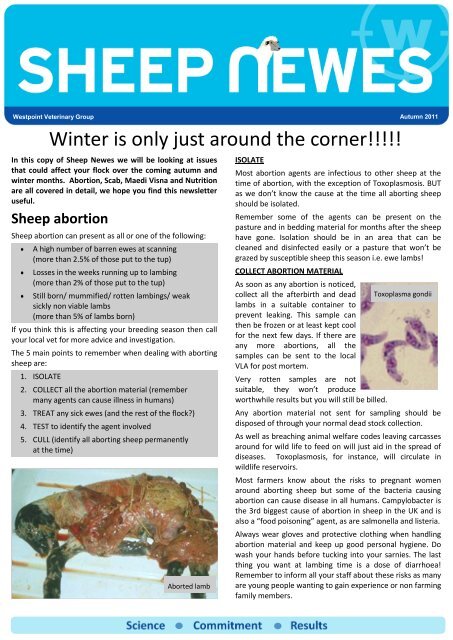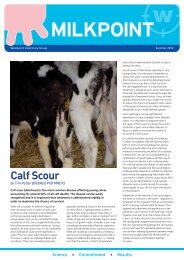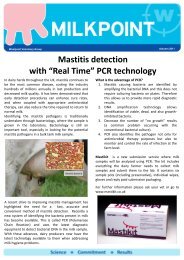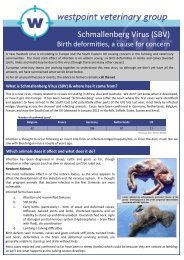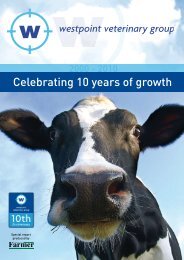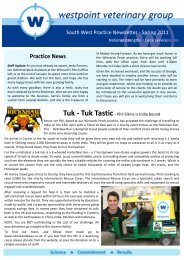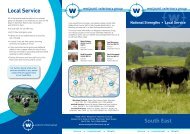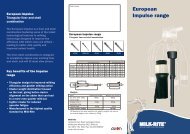Winter is only just around the corner!!!!! - Westpoint Veterinary Group
Winter is only just around the corner!!!!! - Westpoint Veterinary Group
Winter is only just around the corner!!!!! - Westpoint Veterinary Group
- No tags were found...
You also want an ePaper? Increase the reach of your titles
YUMPU automatically turns print PDFs into web optimized ePapers that Google loves.
<strong>Westpoint</strong> <strong>Veterinary</strong> <strong>Group</strong>Autumn 2011<strong>Winter</strong> <strong>is</strong> <strong>only</strong> <strong>just</strong> <strong>around</strong> <strong>the</strong> <strong>corner</strong>!!!!!In th<strong>is</strong> copy of Sheep Newes we will be looking at <strong>is</strong>suesthat could affect your flock over <strong>the</strong> coming autumn andwinter months. Abortion, Scab, Maedi V<strong>is</strong>na and Nutritionare all covered in detail, we hope you find th<strong>is</strong> newsletteruseful.Sheep abortionSheep abortion can present as all or one of <strong>the</strong> following:A high number of barren ewes at scanning(more than 2.5% of those put to <strong>the</strong> tup)Losses in <strong>the</strong> weeks running up to lambing(more than 2% of those put to <strong>the</strong> tup)Still born/ mummified/ rotten lambings/ weaksickly non viable lambs(more than 5% of lambs born)If you think th<strong>is</strong> <strong>is</strong> affecting your breeding season <strong>the</strong>n callyour local vet for more advice and investigation.The 5 main points to remember when dealing with abortingsheep are:1. ISOLATE2. COLLECT all <strong>the</strong> abortion material (remembermany agents can cause illness in humans)3. TREAT any sick ewes (and <strong>the</strong> rest of <strong>the</strong> flock?)4. TEST to identify <strong>the</strong> agent involved5. CULL (identify all aborting sheep permanentlyat <strong>the</strong> time)Aborted lambISOLATEMost abortion agents are infectious to o<strong>the</strong>r sheep at <strong>the</strong>time of abortion, with <strong>the</strong> exception of Toxoplasmos<strong>is</strong>. BUTas we don’t know <strong>the</strong> cause at <strong>the</strong> time all aborting sheepshould be <strong>is</strong>olated.Remember some of <strong>the</strong> agents can be present on <strong>the</strong>pasture and in bedding material for months after <strong>the</strong> sheephave gone. Isolation should be in an area that can becleaned and d<strong>is</strong>infected easily or a pasture that won’t begrazed by susceptible sheep th<strong>is</strong> season i.e. ewe lambs!COLLECT ABORTION MATERIALAs soon as any abortion <strong>is</strong> noticed,collect all <strong>the</strong> afterbirth and deadlambs in a suitable container toprevent leaking. Th<strong>is</strong> sample can<strong>the</strong>n be frozen or at least kept coolfor <strong>the</strong> next few days. If <strong>the</strong>re areany more abortions, all <strong>the</strong>samples can be sent to <strong>the</strong> localVLA for post mortem.Very rotten samples are notsuitable, <strong>the</strong>y won’t produceworthwhile results but you will still be billed.Toxoplasma gondiiAny abortion material not sent for sampling should bed<strong>is</strong>posed of through your normal dead stock collection.As well as breaching animal welfare codes leaving carcasses<strong>around</strong> for wild life to feed on will <strong>just</strong> aid in <strong>the</strong> spread ofd<strong>is</strong>eases. Toxoplasmos<strong>is</strong>, for instance, will circulate inwildlife reservoirs.Most farmers know about <strong>the</strong> r<strong>is</strong>ks to pregnant women<strong>around</strong> aborting sheep but some of <strong>the</strong> bacteria causingabortion can cause d<strong>is</strong>ease in all humans. Campylobacter <strong>is</strong><strong>the</strong> 3rd biggest cause of abortion in sheep in <strong>the</strong> UK and <strong>is</strong>also a “food po<strong>is</strong>oning” agent, as are salmonella and l<strong>is</strong>teria.Always wear gloves and protective clothing when handlingabortion material and keep up good personal hygiene. Dowash your hands before tucking into your sarnies. The lastthing you want at lambing time <strong>is</strong> a dose of diarrhoea!Remember to inform all your staff about <strong>the</strong>se r<strong>is</strong>ks as manyare young people wanting to gain experience or non farmingfamily members.
Sheep Abortion CONT...TREATOnce <strong>the</strong> sheep <strong>is</strong> <strong>is</strong>olated it should be treated if it <strong>is</strong> sick;campylobacter, salmonella and l<strong>is</strong>terios<strong>is</strong> will make ewes ill.Antibiotics and anti-inflammatory injections should begiven, consult your vet as to <strong>the</strong> most suitable for <strong>the</strong>clinical signs. Keep <strong>the</strong> ewe hydrated by drenching, addpro-rumen and propylene glycol to warm water, as mostewes won’t eat and drink when sick and it <strong>is</strong> oftendehydration related problems that can cause death.D<strong>is</strong>cuss with your vet <strong>the</strong> pros and cons of treating <strong>the</strong> restof <strong>the</strong> flock. Some of <strong>the</strong> abortion agents will respond torelatively inexpensive drug treatment and may preventfur<strong>the</strong>r abortions, especially if you have a protractedlambing period.However, many of <strong>the</strong> agents responsible will have alreadycaused <strong>the</strong> abortion so treatment at <strong>the</strong> time will havelimted effect: post-mortem or blood results will obviouslyhelp you make th<strong>is</strong> dec<strong>is</strong>ion.CULLAll aborting sheep should be permanently identified as such.She should not be used as a foster mo<strong>the</strong>r, as Chlamydiaespecially <strong>is</strong> known to be passed on through vaginald<strong>is</strong>charge after lambing. If you want to keep <strong>the</strong> ewe to rearorphans, <strong>only</strong> adopt if lambs are destined for killing and cullher out at weaning.Some abortion agents <strong>the</strong> ewe can recover from, such ascampylobacter and gain immunity for <strong>the</strong> following year.But <strong>the</strong> commonest agent responsible for 50% of sheepabortion in <strong>the</strong> UK <strong>is</strong> contagious all year round.TESTIt <strong>is</strong> worth remembering that 2% of your flock can abortthrough “natural causes”, but no one knows at <strong>the</strong> start ofan abortion “storm” how many will abort. The moresamples you send to <strong>the</strong> VLA, <strong>the</strong> more likely you are to geta definitive answer as to <strong>the</strong> cause.If <strong>the</strong> first sign of a problem <strong>is</strong> a high number of barren ewesat scanning, or retrospectively you think a high number oflambs were lost from scanning to turn out, samples can betaken from a number of ewes, to identify an immuneresponse to <strong>the</strong> two commonest abortion agents. Th<strong>is</strong> againwill help make dec<strong>is</strong>ions on next year’s management.Chlamydia can be passed on through abortion material too<strong>the</strong>r sheep at lambing time. Some ewes will become“carriers” intermittently shedding <strong>the</strong> organ<strong>is</strong>m in faeceswhich can <strong>the</strong>n spread to o<strong>the</strong>r sheep throughout <strong>the</strong> year.It <strong>is</strong> thought that <strong>the</strong>se carrier sheep could also contaminatelive lambs born to <strong>the</strong>m or those in close contact such asfostered lambs. If <strong>the</strong>se lambs are <strong>the</strong>n kept asreplacements, <strong>the</strong>y will suffer fertility or abortion problems.A sheep can be exposed to <strong>the</strong> organ<strong>is</strong>m at any point in <strong>the</strong>year and will <strong>the</strong>n abort at her next pregnancy.Sexually transmitted infection can affect tups. In <strong>the</strong> initialstages, <strong>the</strong> infection can be passed on to ewes throughsemen. In <strong>the</strong> long term it can cause abnormalities in <strong>the</strong>testicles.Toxoplasmos<strong>is</strong>, however, <strong>is</strong> different. Once a ewe hasaborted it will acquire immunity and will not abort again norspread <strong>the</strong> infection to o<strong>the</strong>r sheep.The agent <strong>is</strong> carried by cats which ingest <strong>the</strong> organ<strong>is</strong>m frominfected sheep material or infected vermin. The cats excreteit in <strong>the</strong>ir faeces and urine which <strong>the</strong> ewe <strong>the</strong>n ingeststhrough contaminated feed or pasture.Often, despite best efforts, responsible organ<strong>is</strong>ms are notidentified, or more than one can be responsible in onelambing season. So unless a clear cause of <strong>the</strong> abortion <strong>is</strong>identified, culling all sheep that abort would be <strong>the</strong> bestpolicy.
Maedi V<strong>is</strong>naMaedi V<strong>is</strong>na (MV) <strong>is</strong> a viral d<strong>is</strong>ease that affects sheep. Thename <strong>is</strong> formed from two Icelandic words that describe <strong>the</strong>clinical signs it produces: Maedi “laboured breathing” (<strong>the</strong>respiratory form) and V<strong>is</strong>na “wasting” causing neurologicalsigns (<strong>the</strong> rarer form). It <strong>is</strong> similar to HIV in humans as itattacks <strong>the</strong> immune system. CAE (Caprine Arthrit<strong>is</strong> andEncephalit<strong>is</strong>) <strong>is</strong> a related d<strong>is</strong>ease affecting goats and <strong>the</strong>re <strong>is</strong>evidence that cross infection can occur between species.The d<strong>is</strong>ease occurs worldwide and first entered <strong>the</strong> UKabout 20 years ago. It <strong>is</strong> an important d<strong>is</strong>ease both clinicallyand economically, as it <strong>is</strong> difficult to diagnose, <strong>the</strong>re <strong>is</strong> nocure and no vaccine. Once <strong>the</strong> animal shows clinical signs it<strong>is</strong> invariably fatal. Affected farms have increased cullingrates, increased lamb mortality, reduced growth rates, aswell as increased incidence of arthrit<strong>is</strong>, premature birth andreduction in conception.The d<strong>is</strong>ease <strong>is</strong> spread by inhalation and via colostrum andmilk. MV can infect sheep of any age, but mainly infectslambs and <strong>the</strong>n <strong>the</strong>y are infected for life. However, <strong>the</strong>ymay not show any signs of d<strong>is</strong>ease until <strong>the</strong>y are over 3years old. The clinical signs include:-Pneumonia - respiratory d<strong>is</strong>tress but no fever,exudate or depressionProgressive hindlimb paralys<strong>is</strong>Nervous signsWastingArthrit<strong>is</strong>/lamenessChronic mastit<strong>is</strong>Different breeds appear to have different susceptibility. Forexample <strong>the</strong> Texel appears to be more susceptible, while<strong>the</strong> Suffolk <strong>is</strong> more res<strong>is</strong>tant to <strong>the</strong> d<strong>is</strong>ease.The d<strong>is</strong>ease can be tested for via a blood test to look forantibodies, and <strong>the</strong>re <strong>is</strong> a MV accreditation scheme run by<strong>the</strong> SAC (Scott<strong>is</strong>h Agricultural College), which has <strong>around</strong>3,500 members. A flock can become MV Accredited Freewhen it passes two qualifying blood tests between 6 and 12months apart and has certification from a vet that <strong>the</strong> farm<strong>is</strong> complying with <strong>the</strong> scheme rules and conditions. OnceMV accredited, a proportion of <strong>the</strong> flock <strong>is</strong> blood testedevery 2 years and <strong>the</strong> member <strong>is</strong> <strong>is</strong>sued with certificates ofstatus for selling or moving scheme sheep. Shows and salesare licensed to provide space for MV accredited sheep. AnMV monitored scheme <strong>is</strong> available for commercial flockmasters who are unable to totally <strong>is</strong>olate <strong>the</strong>ir flock.The benefits of <strong>the</strong> scheme are as follows:-Helps reduce <strong>the</strong> r<strong>is</strong>k of your flock contracting MVGives membership of a nationally recogn<strong>is</strong>edhealth schemeAllows export to certain countries free from MVGives added value to <strong>the</strong> flockAllows attendance at shows and sales from whichanimals would o<strong>the</strong>rw<strong>is</strong>e be bannedFor more information on MV, sheep or goat accreditationschemes, please contact your vet.Nutritional management of <strong>the</strong> pregnant eweNutrition of <strong>the</strong> pregnant ewe <strong>is</strong> an area that will have significant impact on production and <strong>the</strong>refore profit, and <strong>is</strong>dependent on four major factors, three of which can be managed between scanning and lambing time.Body Condition Score (BCS). Th<strong>is</strong> <strong>is</strong> <strong>the</strong> key to lamb survival and growth rate. We know that multiple bearing ewes that lambwith BCS less than 3 (1-5 scale) will have a lower lamb survival rate and will wean smaller lambs. Identifying low BCSmultiple ewes early gives time to rescue <strong>the</strong>m before lambing. To add a single body condition score requires <strong>around</strong> 30kg ofdry matter (DM) over and above that required for maintenance and pregnancy. If th<strong>is</strong> <strong>is</strong> not detected till after scanning <strong>the</strong>n<strong>the</strong>y will <strong>only</strong> have <strong>around</strong> 50 days meaning <strong>the</strong>y will have to consume <strong>around</strong> ½ kg DM extra each day, but th<strong>is</strong> requires <strong>the</strong>extra to be available…. do you know how much you have?Feed intake approaching lambing. Multiple ewes underfed in <strong>the</strong> last 5-6 weeks of pregnancy will have lower lamb survivaland will wean lighter lambs. Th<strong>is</strong> does not mean feeding excess (th<strong>is</strong> can also be detrimental) but ra<strong>the</strong>r making sure that<strong>the</strong>y hold condition. In grazing terms, if out at pasture, it means not grazing below 1100kg DM/ha; in housed ewes it <strong>is</strong>easier to regularly check BCS to assess adequacy of feeding. Making sure adequate feed of good quality <strong>is</strong> available over <strong>the</strong>winter months means pre-planning and if supplements are sourced early can mean savings in feed costs. Knowing if yourewes are single or multiple bearing <strong>is</strong> important as it will enable you to feed to demand; for example at 20 weeks ofgestation a 50kg ewe bearing twins will require approximately 30% more energy (MJ ME) than her counterpart with <strong>only</strong> asingle lamb! Adequacy of nutrition during <strong>the</strong> lead up to lambing will also help to reduce <strong>the</strong> r<strong>is</strong>k of metabolic d<strong>is</strong>eases,pregnancy toxaemia and will improve colostrum quality/absorption and <strong>the</strong>refore lamb survival and health.Adequate feed allocation at lambing. Lambing multiple bearing ewes on good pasture/with good feed allowances whenhoused will ensure maximal lactation performance. When housed it <strong>is</strong> important to make sure access to feed <strong>is</strong> notrestricted/limited due to space and when at pasture it <strong>is</strong> making sure grazing above 1200kg DM/ha with appropriatestocking densities. Pasture will need to be assessed for growth rate to ensure it can meet demand and determine if/whensupplements may be called for. The fourth factor <strong>is</strong> feeding after lambing and making sure it <strong>is</strong> of good quality and quantityin late lactation; it <strong>is</strong> vital to ensure adequate protein and energy to ensure good even growth. Th<strong>is</strong> will play a large part inweaning weights and <strong>the</strong>refore profit!
Sheep ScabSheep scab <strong>is</strong> an allergic dermatit<strong>is</strong> caused by <strong>the</strong> mite Psoroptes ov<strong>is</strong> and Psoroptes cuniculi. Known by several names <strong>the</strong>proper name <strong>is</strong> Psoroptic mange. Sheep scab seriously affects <strong>the</strong> welfare of sheep and has significant financial impactthrough its effect on <strong>the</strong> condition of ewes, <strong>the</strong> growth rate of lambs, damage to wool and reduced quality of sheepskins. Scabmites feeding on <strong>the</strong> skin surface cause intense irritation to <strong>the</strong> sheep that results in <strong>the</strong>m rubbing and scratching. The d<strong>is</strong>ease<strong>is</strong> more common in <strong>the</strong> winter and spring when <strong>the</strong> sheep have full fleeces. In <strong>the</strong> early autumn or early winter, flock ownersshould look to assess <strong>the</strong>ir flock’s scab status and treat accordingly. Whenever possible, flock owners should co-ordinate anytreatment or control measures with <strong>the</strong>ir neighbours to gain <strong>the</strong> maximum benefit from <strong>the</strong>ir time and effort. Th<strong>is</strong> approachhas been employed successfully in Scotland and <strong>is</strong> promoted by <strong>the</strong> Scott<strong>is</strong>h Sheep Scab Initiative. When assessing scab statusyou should consider:Is <strong>the</strong>re evidence of scab?Were ALL introduced sheep treated for scab and held inquarantine for three weeks?Are boundaries secure – scab and sheep proof?Are neighbouring flocks infected or at r<strong>is</strong>k of infection?The d<strong>is</strong>ease: The mange mites migrate to all parts of <strong>the</strong> skin. As <strong>the</strong>yfeed, <strong>the</strong>y puncture <strong>the</strong> skin to drink <strong>the</strong> fluid that accumulates. In doingso <strong>the</strong>y cause irritation through bru<strong>is</strong>ing, leading to <strong>the</strong> character<strong>is</strong>ticitching. The lesions ooze and scabs are formed. Left unchecked <strong>the</strong> scabscan spread over much of <strong>the</strong> body and ultimately to <strong>the</strong> death of <strong>the</strong>sheep.Transm<strong>is</strong>sion: The mites are spread primarily from direct contact from sheep to sheep. Infected prem<strong>is</strong>es can also possibly actas mechan<strong>is</strong>ms of transm<strong>is</strong>sion as <strong>the</strong> mites can survive on pieces of wool in <strong>the</strong> environment.What to look for: In <strong>the</strong> initial stages of <strong>the</strong> d<strong>is</strong>ease, <strong>the</strong> lesions formed are very small (less than 6mm) and can be very hardto detect. What you will see are signs of itchiness i.e. biting, scratching and general unrest. If th<strong>is</strong> <strong>is</strong> noticed it <strong>is</strong> best toexamine <strong>the</strong> skin surface in search of scabs. These scabs will usually have a thin yellow crust or will be red and oozing a clearfluid. Sites to look closely at are <strong>the</strong> ears, base of <strong>the</strong> horns and <strong>around</strong> <strong>the</strong> scrotum and anus in <strong>the</strong> ram.Sheep scabSheep scab miteTreatment and control: Th<strong>is</strong> requires careful planning and afarm strategy including:Environment - prem<strong>is</strong>es and fields should be left vacant fortwo weeks following sheep batches. Th<strong>is</strong> allows <strong>the</strong>m to beregarded as clean. Any residual mites will have died andcross infection <strong>the</strong>re by prevented.Quarantine and biosecurity - When new animals areintroduced <strong>the</strong>y should be treated before entering <strong>the</strong> unitor mixing with o<strong>the</strong>r sheep.Dipping - sheep need to be immersed in <strong>the</strong> dip to ensurecomplete coverage. The dip requires careful monitoring fromhealth and safety regulations and to ensure an activeconcentration of <strong>the</strong> dip!Injection - injections of doramectin (Dectomax at 1ml/33kgonce) or moxidectin (Cydectin at 1ml/50kg twice, 10 daysapart) can be given under <strong>the</strong> skin. Both are effective atkilling <strong>the</strong> mites. In severe outbreaks, injections may need tobe repeated in 10 days time.Note: Careful planning following treatment <strong>is</strong> required. Treated or clean sheep must be put into fresh paddocks or sheds with no chance of contact with dirty animals.WESTPOINT VETERINARY GROUP Ltd.Dawes Farm, Bognor Road, Warnham, West Sussex, RH12 3SHTelephone: 01306 628086 Fax: 01306 628080www.westpointfarmvets.co.uk


